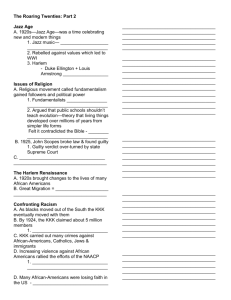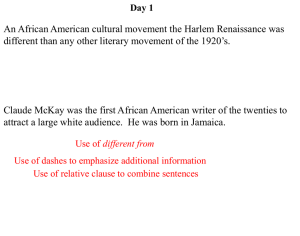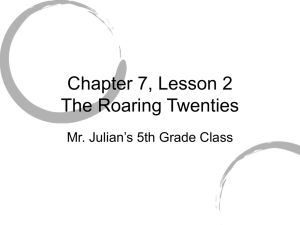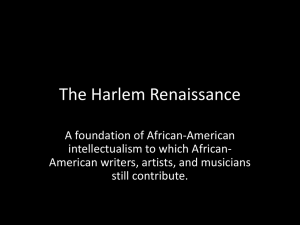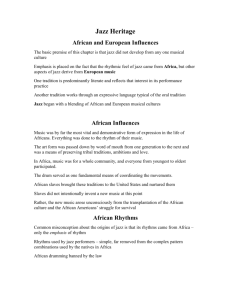chapter 20 section 5 notes
advertisement
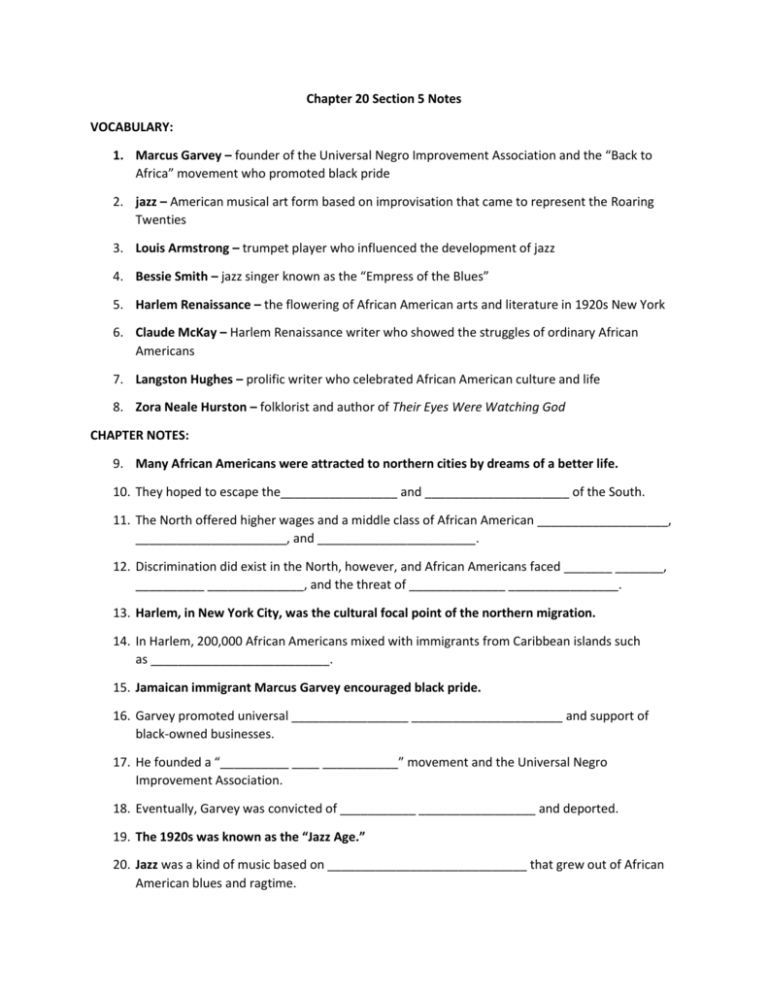
Chapter 20 Section 5 Notes VOCABULARY: 1. Marcus Garvey – founder of the Universal Negro Improvement Association and the “Back to Africa” movement who promoted black pride 2. jazz – American musical art form based on improvisation that came to represent the Roaring Twenties 3. Louis Armstrong – trumpet player who influenced the development of jazz 4. Bessie Smith – jazz singer known as the “Empress of the Blues” 5. Harlem Renaissance – the flowering of African American arts and literature in 1920s New York 6. Claude McKay – Harlem Renaissance writer who showed the struggles of ordinary African Americans 7. Langston Hughes – prolific writer who celebrated African American culture and life 8. Zora Neale Hurston – folklorist and author of Their Eyes Were Watching God CHAPTER NOTES: 9. Many African Americans were attracted to northern cities by dreams of a better life. 10. They hoped to escape the_________________ and _____________________ of the South. 11. The North offered higher wages and a middle class of African American ___________________, ______________________, and _______________________. 12. Discrimination did exist in the North, however, and African Americans faced _______ _______, __________ ______________, and the threat of ______________ ________________. 13. Harlem, in New York City, was the cultural focal point of the northern migration. 14. In Harlem, 200,000 African Americans mixed with immigrants from Caribbean islands such as __________________________. 15. Jamaican immigrant Marcus Garvey encouraged black pride. 16. Garvey promoted universal _________________ ______________________ and support of black-owned businesses. 17. He founded a “__________ ____ ___________” movement and the Universal Negro Improvement Association. 18. Eventually, Garvey was convicted of ___________ _________________ and deported. 19. The 1920s was known as the “Jazz Age.” 20. Jazz was a kind of music based on _____________________________ that grew out of African American blues and ragtime. 21. It began in southern and southwestern cities such as ___________ ______________________. 22. Jazz crossed racial lines to become a uniquely ____________________________ art form. 23. New Orleans trumpet player Louis Armstrong was the unofficial ambassador of jazz. 24. Armstrong played in _________ __________, _________________, and ________ ___________. 25. His expert playing made him a _______________ and influenced the development of jazz. 26. Spread by radio and phonograph records, jazz gained worldwide popularity. 27. ____________ _________________________was a popular band leader who wrote or arranged more than 2,000 pieces of music and earned international honors. 28. Jazz bands featured solo vocalists such as _____________ ________________, the “Empress of the Blues.” 29. White composers such as ____________ _____________, _____________ _____________, and _______________ ____________________ found inspiration in jazz. 30. Jazz and the blues were part of the Harlem Renaissance, a flowering of African American arts and literature. 31. Novelists, poets, and artists celebrated their _____________________and explored questions of race in America. 32. _________ _____________ Cane showed the richness of African American life and folk culture. 33. The writings of __________________ ____________________ emphasized the dignity of African Americans and called for social and political change. 34. ____________ _________________, the most celebrated Harlem Renaissance writer, captured the diversity of everyday African American life in his poetry, journalism, and criticism. 35. ______________ _____________ ________________ published folk tales from her native Florida. Her novel Their Eyes Were Watching God speaks of women’s longing for independence. 36. As the Great Depression began, the Harlem Renaissance came to an end. 37. Yet this artistic movement had a lasting effect on the __________-____________-- of African Americans. 38. It created a sense of group identity and __________________ among African Americans. It later became the cultural bedrock upon which the ________ ___________ movement would be built.



